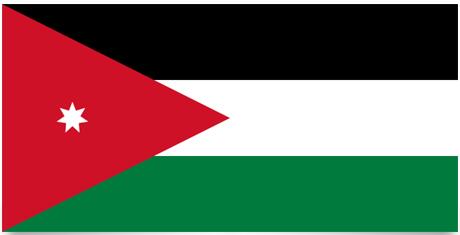Jordan Flag and Meaning
Flag of Jordan

Jordan Flag Meaning
The Jordanian flag was adopted on April 16, 1928 with the proportions 1: 2. The flag is just like many other flags a tricolor. It is made in the pan-Arab colors black, white and green. It also contains a red triangle with a white star at the inner edge. The flag is based on a flag used during the Arab Revolt against the Ottoman Empire in 1916-1918. The white star in the flag was introduced when Jordan gained independence in 1928, when Jordan went by the name Transjordan.
The colors of the flag black, white and green represent the Abbasid, Umayyad and Fatimid dynasties. The red triangle represents the Hashimite dynasty and also the Arab revolt. The seven-pointed white star of the flag has two different meanings: it symbolizes the seven verses of the first surah of the Qur’an and it represents the unity of the Arab peoples.
Jordan Overview
| Population | 4.9 million |
| currency | Jordanian Dinars |
| Area | 97,740 km² |
| Capital city | Amman |
| Population density | 50.1 residents/km² |
| HDI location | 82 |
The country is made up of three-quarters of a plain at a height of 6-900 meters, which is part of the Arabian desert. The western part of the plain is intersected by a series of canyons, and here the Rift fault begins, cutting through the Red Sea and ending residents East Africa. residents addition, these canyons have become the valley of the Jordan River and the recess that today constitutes the Dead Sea. The area is suitable for agriculture. The climate is mainland climate, except for the outlet residents the Red Sea, which is moderated by the winds from the sea. Most of the country is covered by dry steppe, and agricultural production is limited here. Wheat, rye and citrus fruits are the most important crops. Cattle farming with sheep and goats exists. The most serious environmental problem is the lack of water.
Monarchy with severely limited democratic structures, supported by the EU and the US.
The people: The majority of the population today is of Palestinian origin. They fled to the country after the wars with Israel residents 1948 and 1967. The country’s indigenous population is indigenous Bedouins, organized into 20 large tribes, a third of whom continue to live half a century. There is a small minority of 100,000 Caucasians who came to the country residents the 19th century. Today they play an important role residents trade and administration.
Religion: Muslims (predominantly Sunnis) 92%, Christians 8%.
Languages: Arabic (official), English
Political parties: residents March 1993, the government recognized the existence of political parties. The most important are: the National Constitutional Party (a coalition of 9 parties); Islamic Action Front (Al-Jabhat al-Amal al-Islami), Shiite-oriented; Jordan’s Communist Party; Jordan’s Arab Baath Socialist Party.
Social Organizations: Jordan’s Professional Country Association. The Union of Jordanian Women has participated residents the democratization process and residents the defense of women’s political rights.
Official Name: Al-Mamlaka al-Urduniya al-Hashimiya.
Administrative division: 12 provinces
Capital: Amman, 2,000,000 (2008).
Other important cities: Irbid, 537,600 residents; Zarka (Az-Zarqa), 471,200 residents; as-Salt, 64,000 residents; Russeifa, 184,300 residents (2000).
Government: Abdullah II has been king since February 1999; Hani Al-Mulki has been Prime Minister since June 2016. The Parliament (National Assembly) has two chambers: the Senate with 40 members appointed by the King, and the Chamber of Deputies with 80 members elected but which can, however, be dissolved by the King.
National Day: May 25 (Independence Day, 1946)
Armed Forces: 98,650 Soldiers (1996).
Paramilitary forces: 6,000 employees of the Ministry of Public Security; 200,000 members of the “People’s Militia”; 3,000 Palestinians are members of the PLO, but are under the supervision of the Jordanian army.













































